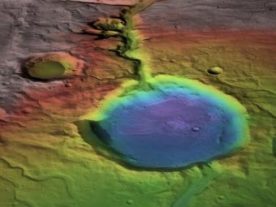
Time-lapse photograph of one of the last Cosmic Infrared Background Experiment (CIBER) rocket launchses. Image was taken in 2013 at NASA’s Wallops Flight Facility in Virginia. (T. Arai/University of Tokyo)
Analysis of observations gathered by the first two Cosmic Infrared Background Experiment (CIBER) missions shows that the universe shines much brighter that had been thought.
CIBER scientists found that infrared light in what were thought to be dark areas of space between galaxies is producing a glow that gleams as brightly as all the known galaxies combined.
This glow was first detected by scientists working with NASA’s Spitzer Space Telescope.

Our sky is filled with a diffuse background glow, known as the cosmic infrared background. (Adolf Schaller/STScI , Hubble Legacy Archive, NASA, ESA, Judy Schmidt)
The team’s findings, which are outlined in a paper just published by the journal Science, could prompt scientists to rethink galaxy structure. Galaxy boundaries may not be as well defined as thought, but instead stretch out over a great distance to create an immense and interconnected ocean of stars.
Members of the CIBER team, which is an international group of scientists from various universities and government laboratories, hope their findings will help settle whether this infrared glow is something produced by a flow of individual stars stripped from their galaxies as a result of galactic collisions, or from the first galaxies formed in the universe.
“We think stars are being scattered out into space during galaxy collisions,” said the paper’s lead author, Michael Zemcov, an astronomer at the California Institute of Technology (Caltech) and NASA’s Jet Propulsion Laboratory (JPL) in Pasadena, California. “While we have previously observed cases where stars are flung from galaxies in a tidal stream, our new measurement implies this process is widespread.”

This graphic illustrates how the Cosmic Infrared Background Experiment, or CIBER, team measures a diffuse glow of infrared light filling the spaces between galaxies. (NASA/JPL-Caltech)
The theory that this background light is produced by the stream of orphaned stars gained even more favor after the CIBER team noticed that the infrared light appeared to be too bright and too blue to originate from the earliest galaxies of the universe.
Those first galaxies, according to the CIBER team, would produce colors of light that would much more red than what was observed.
“The simplest explanation, which best explains the measurements, is that many stars have been ripped from their galactic birthplace, and that the stripped stars emit on average about as much light as the galaxies themselves,” said CIBER project principal investigator James Bock from Caltech and JPL.
From 2010 until 2013, the CIBER project launched a total of four suborbital “sounding rockets,” each carrying a package of instruments that allowed the international group of universities and government laboratories to characterize near infrared (IR) background light.
CIBER’s instruments took images of the cosmic background light at two infrared wavelengths shorter than can be detected by the Spitzer Space Telescope.
CIBER scientists had to make their observations and conduct their studies from instruments that were in flown into space since Earth’s own atmosphere also happens to glow brilliantly at the very same wavelengths of light that were needed to make their studies.
NASA/Jet Propulsion Laboratory Video























Comments are closed.